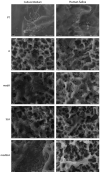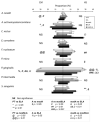Influence of topography and hydrophilicity on initial oral biofilm formation on microstructured titanium surfaces in vitro
- PMID: 21492236
- PMCID: PMC4287405
- DOI: 10.1111/j.1600-0501.2011.02184.x
Influence of topography and hydrophilicity on initial oral biofilm formation on microstructured titanium surfaces in vitro
Abstract
Objectives: The aim of this study was to analyse the influence of the microtopography and hydrophilicity of titanium (Ti) substrates on initial oral biofilm formation.
Materials and methods: Nine bacterial species belonging to the normal oral microbiota, including: Aggregatibacter actinomycetemcomitans, Actinomyces israelii, Campylobacter rectus, Eikenella corrodens, Fusobacterium nucleatum, Parvimonas micra, Porphyromonas gingivalis, Prevotella intermedia, and Streptococcus sanguinis were tested on Ti surfaces: pretreatment (PT [R(a) <0.2 μm]), acid-etched (A [R(a) <0.8 μm]), A modified to be hydrophilic (modA), sand-blasted/acid-etched (SLA [R(a) =4 μm]), and hydrophilic SLA (modSLA). Disks were incubated for 24 h in anaerobic conditions using a normal culture medium (CM) or human saliva (HS). The total counts of bacteria and the proportion of each bacterial species were analysed by checkerboard DNA-DNA hybridization.
Results: Higher counts of bacteria were observed on all surfaces incubated with CM compared with the samples incubated with HS. PT, SLA, and modSLA exhibited higher numbers of attached bacteria in CM, whereas SLA and modSLA had a significant increase in bacterial adhesion in HS. The proportion of the species in the initial biofilms was also influenced by the surface properties and the media used: SLA and modSLA increased the proportion of species like A. actinomycetemcomitans and S. sanguinis in both media, while the adhesion of A. israelii and P. gingivalis on the same surfaces was affected in the presence of saliva.
Conclusions: The initial biofilm formation and composition were affected by the microtopography and hydrophilicity of the surface and by the media used.
© 2011 John Wiley & Sons A/S.
Figures



Similar articles
-
Interactions between endothelial progenitor cells (EPC) and titanium implant surfaces.Clin Oral Investig. 2013 Jan;17(1):301-9. doi: 10.1007/s00784-012-0691-7. Epub 2012 Mar 10. Clin Oral Investig. 2013. PMID: 22406922
-
In Vitro Biofilm Formation on Titanium and Zirconia Implant Surfaces.J Periodontol. 2017 Mar;88(3):298-307. doi: 10.1902/jop.2016.160245. Epub 2016 Oct 7. J Periodontol. 2017. PMID: 27712464
-
Effects of hydrophilicity and microtopography of titanium implant surfaces on initial supragingival plaque biofilm formation. A pilot study.Mund Kiefer Gesichtschir. 2007 Dec;11(6):333-8. doi: 10.1007/s10006-007-0079-z. Mund Kiefer Gesichtschir. 2007. PMID: 17940813
-
Initial attachment, subsequent cell proliferation/viability and gene expression of epithelial cells related to attachment and wound healing in response to different titanium surfaces.Dent Mater. 2012 Dec;28(12):1207-14. doi: 10.1016/j.dental.2012.08.007. Epub 2012 Oct 17. Dent Mater. 2012. PMID: 23083807
-
The adhesion of oral bacteria to modified titanium surfaces: role of plasma proteins and electrostatic forces.Clin Oral Implants Res. 2013 Aug;24 Suppl A100:49-56. doi: 10.1111/j.1600-0501.2011.02364.x. Epub 2011 Dec 13. Clin Oral Implants Res. 2013. PMID: 22150723
Cited by
-
Effect of UV-photofunctionalization on oral bacterial attachment and biofilm formation to titanium implant material.Biomaterials. 2015 Oct;67:84-92. doi: 10.1016/j.biomaterials.2015.07.030. Epub 2015 Jul 17. Biomaterials. 2015. PMID: 26210175 Free PMC article.
-
Biological characterization of surface-treated dental implant materials in contact with mammalian host and bacterial cells: titanium versus zirconia.RSC Adv. 2019 Oct 9;9(55):32097-32109. doi: 10.1039/c9ra06010c. eCollection 2019 Oct 7. RSC Adv. 2019. PMID: 35530755 Free PMC article.
-
Evaluation of the role of substrate and albumin on Pseudomonas aeruginosa biofilm morphology through FESEM and FTIR studies on polymeric biomaterials.Prog Biomater. 2017 May;6(1-2):27-38. doi: 10.1007/s40204-017-0061-2. Epub 2017 Feb 2. Prog Biomater. 2017. PMID: 28155216 Free PMC article.
-
Nanotopography and oral bacterial adhesion on titanium surfaces: in vitro and in vivo studies.Braz Oral Res. 2024 Mar 11;38:e021. doi: 10.1590/1807-3107bor-2024.vol38.0021. eCollection 2024. Braz Oral Res. 2024. PMID: 38477807 Free PMC article.
-
Ways to control harmful biofilms: prevention, inhibition, and eradication.Crit Rev Microbiol. 2021 Feb;47(1):57-78. doi: 10.1080/1040841X.2020.1842325. Epub 2020 Dec 28. Crit Rev Microbiol. 2021. PMID: 33356690 Free PMC article. Review.
References
-
- An YH, Friedman RJ. Concise review of mechanisms of bacterial adhesion to biomaterial surfaces. Journal of Biomedical Materials Research. 1998;43:338–348. - PubMed
-
- Barbour ME, O’Sullivan DJ, Jenkinson HF, Jagger DC. The effects of polishing methods on surface morphology, roughness and bacterial colo- nisation of titanium abutments. Journal of Materials Science: Materials in Medicine. 2007;18:1439–1447. - PubMed
-
- Bos R, van der Mei HC, Busscher HJ. Physico-chemistry of initial microbial adhesive interactions – its mechanisms and methods for study. FEMS Microbiology Reviews. 1999;23:179–230. - PubMed
-
- BoulangePetermann L, Rault J, BellonFontaine MN. Adhesion of Streptococcus thermophilus to stainless steel with different surface topography and roughness. Biofouling. 1997;11:201–216.
-
- Buser D, Broggini N, Wieland M, Schenk RK, Denzer AJ, Cochran DL, Hoffmann B, Lussi A, Steinemann SG. Enhanced bone apposition to a chemically modified SLA titanium surface. Journal of Dental Research. 2004;83:529–533. - PubMed
Publication types
MeSH terms
Substances
Grants and funding
LinkOut - more resources
Full Text Sources

